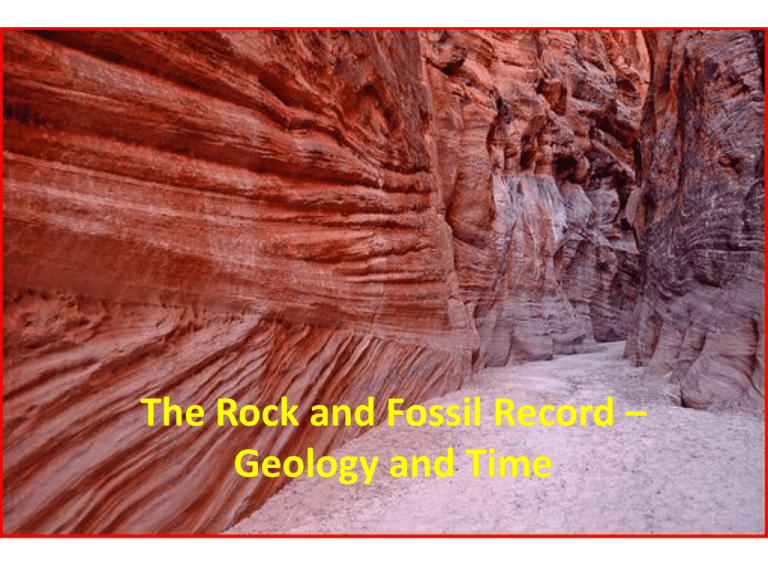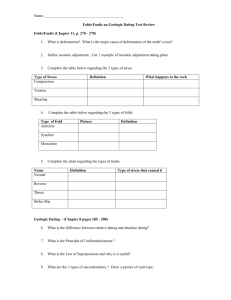Ch 3 Geology & Time
advertisement

The Rock and Fossil Record – Geology and Time Earth’s Story • Catastrophism (#2) – belief that all geologic change happens suddenly. • Rare • Mountains, canyons, seas, etc. • Earth was only a few thousand years old James Hutton & Earth’s Story • Scottish farmer and scientist • Uniformitarianism (#1) – geologic processes that happen today are same as those that happened in the past. • Weathering, erosion, deposition, mountain building (uplift) • Takes a very long time. • Earth was millions of years old • In 1788 he published Theory of the Earth. Charles Lyell’s Contribution • British geologist • Used new evidence to reintroduce uniformitarianism. • 1830-1833, he published 3 volumes called Principles of Geology. • This convinced most scientists and people (including Charles Darwin) that the Earth was indeed very old. A Happy Middle Ground • Both catastrophism and uniformitarianism work to shape the Earth • Most change is gradual (uniformitarianism) • Some change is sudden (catastrophism) •asteroid or meteor impacts •volcanic eruptions •landslides •tsunamis •earthquakes Relative Dating • Relative dating (#3) – determining whether events or objects are younger or older in comparison to other events or objects. • Based on principle of superposition (#4) – younger rocks layers are on top of older layers in undisturbed area – sediments are laid down horizontally – forces can change the position of the layers Draw a picture of 4 rock layers with a fossil in each layer. Label the fossils from oldest to youngest: Absolute Dating • Absolute dating (#5) – any method of measuring the age of an event or object in years – measures a range of years from thousands up to millions • One method is called radiometric dating – Certain atoms have isotopes (#6) – an atom with same number of protons but different number of neutrons – Radioactive decay (#7) is when the unstable isotope atoms break down to stable atoms – A half-life (#8) is the time needed for half the unstable isotope atoms to break down to stable atoms • Radiometric dating (#9) – a method of measuring the percent of remaining isotopes to give the age of the object Types of Radiometric Dating • Potassium-Argon (K→Ar) – potassium-40 has a 1.3 billion year half life – decays to argon and calcium – date rocks older than 100,000 years • Uranium-Lead (U→Pb) – uranium-238 has a 4.5 billion year half life – decays in steps to lead-206 – date rocks older than 10 million years • Rubidium-Strontium (Rb→Sr) – rubidium-87 has a 49 billion year half life – decays to strontium-87 – date rocks older than 10 million years • Carbon-14 (C14→N) – carbon-14 has a 5,730 year half life – decays to nitrogen – date living things no older than 50,000 years Tell your neighbor: What is the difference between relative dating and absolute dating? relative dating compares ages of different objects while absolute dating measures an actual age range of an object Fossils and the Fossil Record • Fossils found in the rock layers (aka fossil record) provide a history of the Earth – Only a rough sketch – Some layers more complete than others – Only a few organisms meet conditions to become fossils • Fossils can be found: – bones and shells preserved in rocks – amber: tree sap – petrifaction: minerals replace organism’s tissues, aka petrified wood – asphalt: organisms trapped in tar pits such at LaBrea tar pits in Los Angeles – frozen: cold slows decay and preserves woolly mammoth Geologic Time Scale • Dividing Earth’s history into sections of time Geologic Time Scale • Eon (#10) – largest division of geologic time – hundreds of millions of years of time – 4 eons • • • • Hadean – hell Archean – ancient Proterozoic – earlier life Phanerozoic – visible life. Most of fossil record in this eon • Era (#11) – 2nd largest division consisting of 2 or more periods – Tens of millions of years – Phanerozoic Eon divided into 3 eras • Paleozoic – ancient life • Mesozoic – middle life • Cenozoic – recent life • Period (#12) – 3rd largest division of geologic time – Millions of years • Epoch (#13) – 4th largest division of time – Hundreds of thousands of years Draw and label a geologic time scale that has the 4 eons and 3 eras on it. Phanerozoic Eon • Paleozoic Era – Age of Fishes – – – – – 543 to 248 million years ago (MYA) Marine life Modern land plants Amphibians, reptiles, insects by end of era Mass extinction killed 90% of species • Mesozoic Era – Age of Reptiles – – – – 248 to 65 MYA Reptiles dominate with small mammals Birds evolved from dinosaurs Mass extinction killed up to 20% of species • Cenozoic Era – Age of Mammals – 65 MYA to present – Mammals dominate Review Questions 1. Who proposed the idea of uniformitarianism? 2. What is catastrophism? 3. What is the principle of superposition? 4. In your own words, write a definition for relative dating. 5. T/F Absolute dating gives the exact, precise age of something. 6. What type of radiometric dating is used to date remains of living things? 7. What are the 4 divisions of geologic time from largest to smallest called? 8. What do each of the following terms mean? - Phanerozoic - Paleozoic - Mesozoic - Cenozoic






